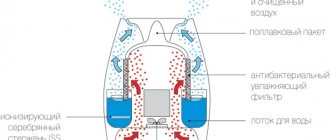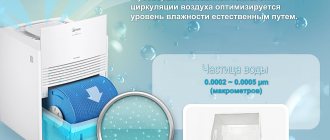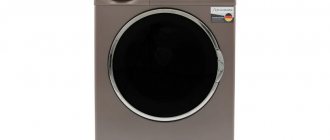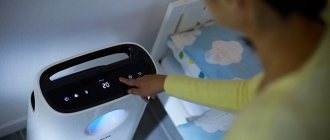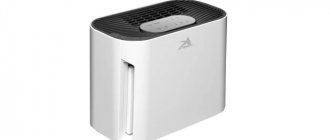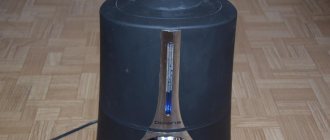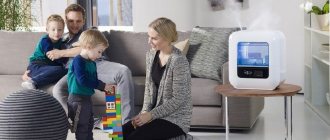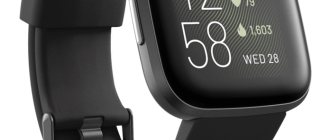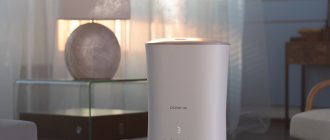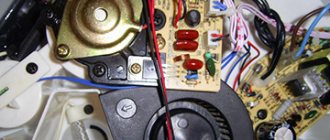- Humidity level detection
- Selecting a model type
- Defining Performance
- Installation methods
- Types of filters
- Noise level
- Control options
- Indicators
- Additional criteria
An air humidifier is a useful household appliance designed to maintain an optimal level of humidity in an apartment and create a pleasant and comfortable microclimate. If the air in the room is constantly dry, a person may begin to experience headaches, difficulty breathing, and his skin and mucous membranes begin to dry out. It also has a negative impact on house plants, which develop poorly and often wither.
In our article we will tell you how to choose and buy an air humidifier and what parameters of the device you need to pay primary attention to.
Humidity level measurement
Before purchasing, it is recommended to take measurements and determine the state of the microclimate in the apartment. For this, a hygrometer is used, which determines the content of water vapor in the air mass. To ensure an objective picture, measurements should be taken over several days. It is best to do this in winter, when the heating radiators are constantly turned on in the house, because they are the main reason for creating a dry indoor climate.
The optimal values are:
- For humans – 40-60%;
- For indoor plants – 55-75%;
- For furniture and parquet – 40-60%;
- For household appliances – 45-60%.
If the hygrometer readings do not correspond to the specified parameters, it is recommended to use the device for humidification.
Why do you need a humidifier?
Since school, we know that a person is 60% water. Therefore, our connection with water cannot be overestimated! People can go without food for a long time, but they cannot live without liquids.
The normal humidity level in an apartment ranges from 30% to 60%. Going beyond the limits - both lower and upper - is not recommended. Air that is too humid is harmful to furniture and appliances in the home, and air that is too dry is harmful to human skin. Household humidifiers are designed to maintain an optimal level of humidity in your home.
What is the benefit of maintaining a normal level of humidity in the house?
- The good condition of the skin, mucous membranes (for example, oral cavity, lips) and hair is maintained. In dry air, hair is more likely to electrify and become brittle. An unpleasant feeling of dryness appears on the palms - as if they were generously moistened with an antiseptic.
- Houseplants love moisture. Thanks to optimal humidity, wooden flooring or furniture, as well as wallpaper, paintings, photographs and other things lose their luster more slowly. Wallpaper does not crack, photographs do not fade so quickly.
- Less dust. When the air is saturated with moisture, the rising dust is immediately nailed to the floor. Accordingly, less dust means less cleaning of the room.
- It's easier to breathe and cough. Air saturated with moisture penetrates a person’s respiratory tract more easily, which makes coughing more productive. For the same reason, if your moisture level is high, you will snore less while you sleep.
- Prevention of influenza and other colds. Oddly enough, in a humid environment (more than 40%), virus particles die faster. Accordingly, humidifiers can be useful in preventing flu, coronavirus and other diseases.
Maintaining optimal humidity levels is especially important in winter, during the heating season. Batteries dry out the air greatly; humidifiers can curb their negative effects.
Which humidifier to choose
Depending on the operating principle, the devices are divided into several main types (you can read about them in our separate article on the types of air humidifiers).
Here we will briefly describe the features of each type:
- Traditional devices whose operating principle is based on simple evaporation of moisture. Their advantage is the impossibility of waterlogging, since the maximum possible indicator is 60%;
- Steam. To ensure the desired level of humidity, hot steam is used, so the design of the units resembles an electric kettle. For this reason, they are not economical, but at the same time they are characterized by high productivity and the ability to quickly process a large area;
- Ultrasonic. Models of this type are often included in the rating of air humidifiers, as they combine efficiency and excellent performance properties. To convert moisture into steam, a special plate is used that vibrates at an ultrasonic frequency. Then the resulting suspension is sprayed around the room;
- Sinks. These are more functional devices, as they additionally clean the air masses of contaminants. For these purposes, special plastic discs are used that are placed in water. They effectively trap allergens and dust, and also eliminate unpleasant odors. The disadvantages include low productivity;
- Climatic complexes. These are the most complex and advanced products, which are equipped with a multi-stage filtration system and allow maintaining an optimal microclimate in the room.
The best ultrasonic humidifiers
The following humidifiers were included in the ranking of the best:
- Boneco U700.
- Ballu UHB-990.
- Dyson AM10.
- Atmos 2720.
- Tefal HD5120F0.
In order to ensure their functionality, you need to take a closer look at their parameters.
The Boneco U700 model is capable of serving an area of 80 square meters. m. This humidifier produces 600 ml of moisture per hour, while using 180 W. Its dimensions are 36 x 32.5 x 19 cm, and its weight is 4.6 kg. The device is equipped with a hygrostat and a timer. Boneco U700 operates in two modes: cold/warm steam. It has a disinfection system, a humidification intensity regulator, automatic shutdown, a filter cartridge for water purification, a capsule for aromatic oils, and a cleaning indicator. Its average price is 16,000 rubles. The silent Ballu UHB-990 has 2 modes (cold/warm steam), remote control, and a rotary sprayer. This model is equipped with a timer, a capsule for aromatic oils, air ionization and aromatization functions, and low water level indication. The humidifier's performance is 350 ml/h with a power consumption of 30 W. The dimensions of the device are 36.1 x 20.4 x 23.4 cm, weight - 2.5 kg. Action area – 40 sq.m. Average price – 5,000 rubles. Dyson AM10 with Ultraviolet Cleanse technology can neutralize up to 99% of bacteria. The operating area of the model is 30 sq. m. The productivity of the device is 300 ml per hour with a power consumption of 40 W. Its dimensions are 57.9x24x13.5 cm, and its weight is 3.4 kg. The Dyson AM10 has remote control capabilities and an auto-off timer. The range of its humidity settings is 30-70%, and the number of air flow speeds is 10. The device produces a low noise level and is able to operate without additional water for 18 hours. The average price reaches 37,000 rubles. Atmos 2720 is also capable of operating in “cold” and “hot” humidification modes. Its overall dimensions are 280x180x320, weight - 3.25. Power consumption ranges from 32 to 130 W, depending on the evaporation mode. Its coverage area is 45 sq. m. The device is equipped with a hygrometer, timer, and water softening cartridge. And for more convenient use, manufacturers have equipped the product with night display backlighting. Average price – 8,000 rubles. Tefal HD5120F0 can operate without additional water for 18 hours in cold/warm steam modes. Water consumption per hour is 320 ml, with a power consumption of 110 W. The serviced area of the model is 45 sq. m. Device size – 250x410x250, weight – 2.5 kg. The device is equipped with a hygrostat, a demineralizing cartridge, a low water level indicator, a timer and a function for adjusting the evaporation rate. The average price of a model reaches 6,000 rubles.
The cost of air humidifiers varies significantly, but accordingly, their range of functions is different. However, they have one thing in common. Regardless of the chosen model, these devices will never be superfluous in the house, creating a favorable environment.
Performance Metrics
This is one of the key parameters by which an air humidifier for an apartment is selected. Productivity is determined by the ability of the unit to convert water into steam over a certain period of time. It can be indicated in grams per hour or in liters per day.
For classical devices this value is 4-8 liters per day, steam - 7-16 liters, ultrasonic - 7-14 liters. Accordingly, the higher the indicator, the more space the unit can process. In this regard, when choosing a model, it is necessary to take into account the area of the largest room where the product will function.
You also need to pay attention to the capacity of the tank, the volume of which should be selected taking into account the area of the room. For rooms 10-15 sq. meters, a tank of 4-5 liters is enough, for 30-40 - 6-7 liters, 50-60 - 7-9 liters.
Humidifier selection criteria
Let's figure out how to choose the most suitable humidifier for you. We focus on the main criteria that are listed below.
- Design. The first, but less important criterion. Although it is worth paying attention to, since the device you purchase will be in plain sight. Illuminated models are available for sale.
- Serviced area. The area of the room in which the device will effectively perform its duties. Small-sized devices are capable of humidifying the air in a small area, while larger models can take over an entire small apartment.
The area over which a humidifier operates effectively is usually measured in square meters (sqm). This is a fairly approximate value, since many apartments have non-standard sizes. Accordingly, the higher the ceiling height, the more powerful the humidifier you need to purchase.
- Power consumption. Measured in watts. Humidifiers typically use relatively little electricity, but these devices are typically left plugged in all day.
The power of one of the most popular humidifiers on the market - Xiaomi Deerma DEM-F600 - is 25 W. The Okami Air 710 Aqua humidifier, which is capable of operating on an area of up to 90 square meters, consumes 110 W. For comparison, a regular “sixty lamp” consumes 60 W.
- Noise. Typically, air conditioning devices are quite quiet, you can only hear them at maximum power. Very often gurgling sounds are heard when the device is operating. This parameter is measured in decibels.
Most of the devices discussed in this material create noise at a level of 30-40 decibels at maximum operating power. For comparison, 40 decibels is the volume of normal human speech.
- Water consumption and tank volume. The higher the water consumption and the smaller the tank volume, the more often you will have to add water to the humidifier. Classic home humidifiers have a tank volume of about 4-5 liters.
- Water filling type. An inconspicuous but important criterion is that you need to know exactly how water is poured into the humidifier tank. There are usually two types - lower and upper. In the case of the first, you need to disassemble the structure of the device, turn the tank over and pour water into a special hole. In the case of the second, water can be poured into a special hole on top - this type is more convenient.
Bottom water fill using the example of the NEO Clima NHL 220L humidifier (the arrow shows where to pour)
Top water fill using the example of the Xiaomi Smartmi Zhimi Air Humidifier 2
- Automation. As a rule, all humidifiers stop working as soon as the liquid in the tank runs out. Also, almost all devices have a timer with which you can set the operating time before shutting down. The most expensive humidifiers have a built-in hygrometer, which turns off the device when a certain level of humidity is reached (or vice versa - turns it on when the room becomes too humid).
The use of the hygrometer built into the device is very conditional, because it shows the humidity in the immediate vicinity of the device. That is, at a distance of several meters the degree of humidity will be completely different.
- Control. There are three types - mechanical (using a physical button), touch and via an application. The most expensive humidifiers can combine all three types of control.
WetAir MH-410B humidifier touch control buttons
- Adjustment of evaporation intensity. Allows you to vary the power of the device. For example, in hot weather you can set the humidification level to the maximum, and at night you can reduce it to a minimum.
- Smart home function. It is supported by the most expensive models. If the device is built into a smart home, it can be “friended” with other devices and set up automation. For example, when a window is opened, the humidifier will turn off. Or activate at night and turn off in the morning.
- Flavoring. Some devices have a special “pocket” into which you can drip aromatic oils. In this case, the blown air will smell pleasant. However, you can drip aromatic oils directly into the device’s tank, if the instructions allow it.
Compartment for essential or aromatic oils of the Xiaomi DEM-SJS100 humidifier
- Wire length. All humidifiers do not have autonomous power supply and are connected to an outlet. If you do not have enough sockets at home, the length of the network cable is important.
- Price. The cost of climate control devices can start from hundreds of rubles and end in hundreds of thousands (this is the cost of household humidifiers that can “pump up” large rooms). I don’t recommend considering buying cheap devices costing up to 1.5-2 thousand rubles.
In my opinion, the optimal cost of a normal household humidifier ranges from 2 to 10 thousand rubles - depending on the build quality, humidification area, the presence or absence of smart home support and other features.
Installation options
There are two main categories:
- Floor-standing. Usually characterized by significant dimensions and increased productivity, therefore they are actively used for large premises;
- Tabletop. Compact devices that can be installed on any surface. They are convenient to move from one room to another and thereby process the entire house.
Filtration system
Depending on the model and manufacturer, devices may be equipped with various filters or sold without them.
The most common are the following:
- Pre-cleaning. Their task is to remove macroparticles, including dust, wool and hair;
- Electrostatic. They allow you to retain pollen, fine dust, and eliminate odors;
- Plasma. They differ from electrostatic ones by increased (10 times or more) speed of operation;
- Coal. With their help, it is possible to cope with unpleasant odors;
- HEPA filters. Effective elements, since not only allergens are removed, but also particles with sizes starting from 0.3 microns;
- Anti-allergenic. Specially designed to combat bacteria, viruses and spores that cause severe allergies in people;
- Photocatalytic. Their peculiarity is the presence of ultraviolet radiation, which is complemented by the work of the catalyst. Thanks to this, the filter elements destroy harmful bacteria and chemical toxins.
Ultrasonic humidifiers and air purifiers
If we talk about how an air humidifier of this type works, we can immediately note the great efficiency of this technology. A special piezoelectric component is placed within the frame of the ultrasonic humidifier. He, in turn, with the help of high-frequency vibrations, transforms ordinary water into micro-splashes. Dry air is also sucked in here using a fan. This is done through the resulting “water fog”, after which it disperses throughout the room. Air purification is carried out using a special filter.
It is also worth noting that manufacturers of air humidifiers of this type have included the ability to maintain humidity at a strictly defined value. In addition, in most cases, models are equipped with a timer and gyrostat. The advantages also include low noise during its operation. However, this is not without its drawbacks, and in this case it lies in the high cost of a replacement cartridge. In principle, you don’t have to use it without it, but in this case you should use distilled or at least filtered water for filling.
Above we reviewed devices whose main purpose is to improve indoor humidity. There are also devices that can combine humidification with air purification as a result of filtration. Such devices are called humidifiers-air purifiers. This type of humidifier is also classified into two more types of devices – climate control systems and so-called air “washers”.
It is also worth noting that the climate complex is characterized by the intake of polluted air within the premises. Further, the technical characteristics of air humidifiers allow low-quality air masses to be blown through the system, within which there are special filters and water. Thus, the result will be not only humidified, but also clean air. Speaking about the advantages of climate systems, we can immediately note the implementation of a truly comprehensive cleaning of room air flows. At the same time, it is moisturized to the level that is necessary in a given situation. Weakness - regular replacement of filtration components is necessary.
We also make a special mention of air washers, which have a slightly different operating principle, although they have exactly the same goals. They are designed to take air from outside the room, after which it passes through a system consisting of plastic disks that rotate in water. As a result, various harmful impurities will be removed from the air. The latter include dust, cat or dog hair, as well as flower pollen and others. The air will also be humidified to its natural level.
Among the advantages that air washers have is that there is no need to replace replaceable elements. And this, in turn, allows you to save a lot of money while using the device. As in the previous version, in parallel with the moistening of the air masses, they are cleaned. However, they cannot cope with unpleasant odors.
Noise indicators
This criterion is relevant if the device is selected for a children's room or if it is planned to be turned on at night. Xiaomi air humidifiers have some of the lowest noise values, which are equipped with a night mode, in which the sound of the operating fan is almost inaudible.
Most specimens operate within the range of 5-50 dB, and the figure directly depends on the design of the electric motor and its power. For comfortable operation at night, it is desirable that this criterion does not exceed 35 decibels.
Control methods
Manufacturers offer two ways to organize the management of their products:
- Mechanical. More budget models are equipped with it. Typically, products have only two regulators, one of which is responsible for selecting the mode, and with the help of the second you can adjust the duration of operation;
- Electronic. More functional devices with a wide range of settings. Usually there is a display where all relevant information is displayed. There are also many sensors that read the situation in the room, due to which the unit automatically selects the desired mode.
Types of indicators
For user convenience, devices can be equipped with various indicators:
- Inclusions. Signals about connection to the power grid;
- Water level indicator. If such an indicator is present, then when the minimum value is reached, the device will automatically turn off;
- Humidity. A useful option, as it allows you to control the level of humidity in the room;
- Temperatures.
A useful option is the appearance of a light indication if it is necessary to replace or clean a filter.
Additional criteria for choosing an air purifier
Functions that can significantly expand the functionality of the device include:
- Aromatization. For this purpose, special aroma capsules are provided into which aromatic oils are poured;
- Ionization. Saturation of the air mass with negatively charged ions, which promotes better removal of dust, pollen and even dust mites;
- Ozonation. It is used to disinfect airspace from bacteria and viruses, which is especially important during seasonal epidemics;
- Ultraviolet radiation, which is used to more effectively purify the outgoing steam from various microorganisms.
These criteria are the main ones when choosing an air humidifier for an apartment. It is advisable to focus on the manufacturing company and give preference to trusted brands, about whose products you can find only positive reviews.
Main selection criteria
What to look for when choosing a humidifier
Despite the variety of models, all humidifiers have a standard set of functions:
- Performance. The size of the apartment that the device can serve depends on this criterion. Judging by user reviews, a humidifier with a capacity of 300 to 400 ml/h is sufficient for a room up to 30 m2. Powerful devices are capable of working in apartments up to 70 m2 (large two-room apartment). The productivity of such devices reaches 500-600 ml/h. Some people buy humidifiers to grow, but this leads to excessive energy consumption.
- Power. Performance directly depends on power. The right combination of these characteristics affects the cost of operating the humidifier. The more additional functions a model has, the higher the power ratings. Consequently, the amount of energy consumed increases. The average for most humidifiers is between 30 and 35W without additional features included.
- Noise level. When the air is dry, the humidifier will run for hours (especially in winter). The noise level determines how comfortable it is to stay in the same apartment with an operating device. The best models make virtually no sound, allowing you to watch TV, communicate and even sleep with the device turned on. The standard noise level for humidifiers is 25 dB (whisper low).
- Filter type. The effectiveness of the purifier depends on the quality of the filter. If the degree of demineralization is low, then allergens and infection can enter the air along with the steam. For this reason, ion filters have recently gained popularity. Judging by the reviews, they not only moisturize, but also soften the microclimate. A high-quality humidifier can remove inorganic mixtures from the air, including magnesium salts.
2.
